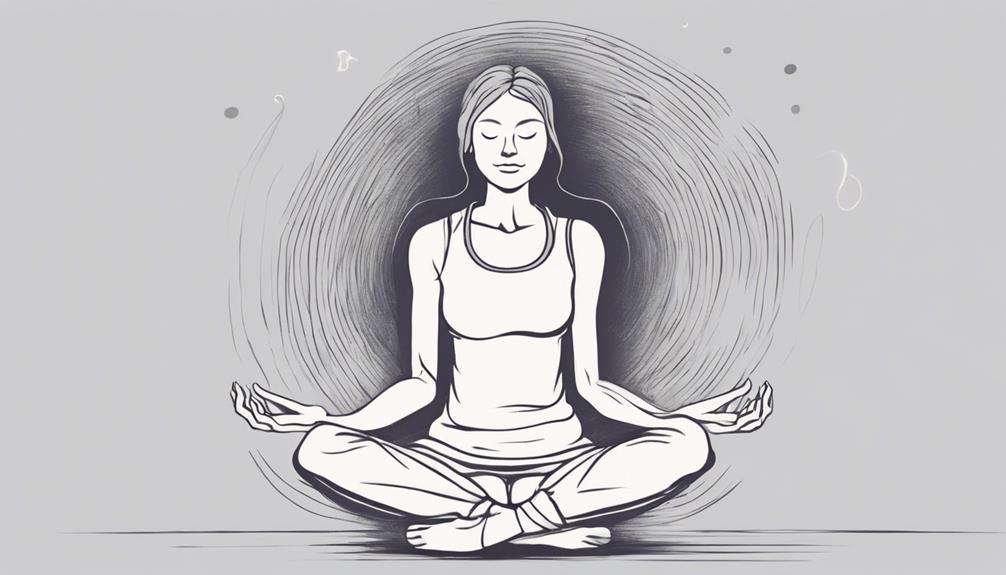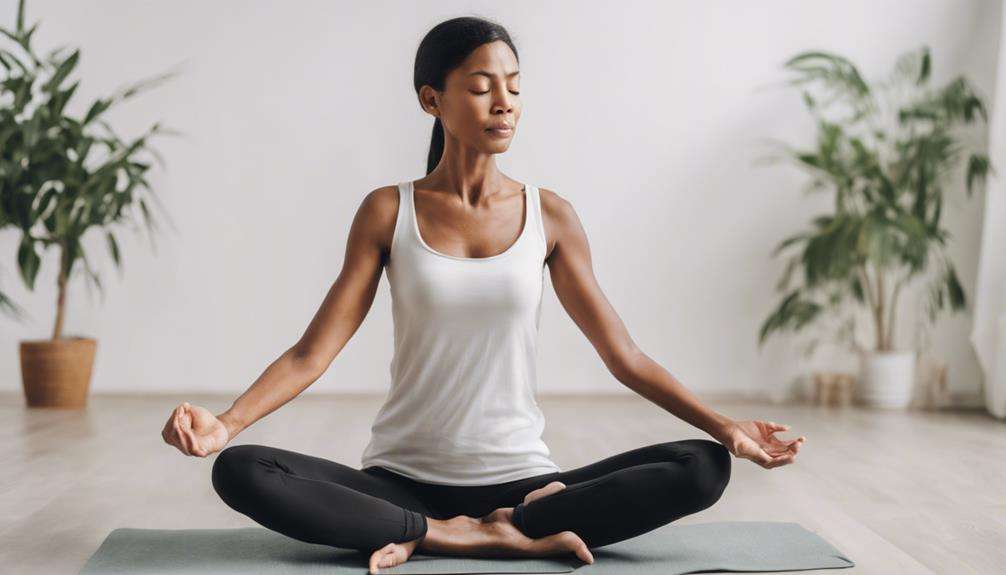If you've ever wondered about a comprehensive way to address pelvic discomfort naturally, exploring a holistic approach might just be the key to finding lasting relief.
By incorporating a combination of physical therapies, natural remedies, and mind-body techniques, you can embark on a journey towards alleviating pelvic pain in a more holistic manner.
From targeted yoga poses and breathing exercises to mindfulness practices and relaxation strategies, there's a wide array of methods waiting for you to discover their potential in enhancing your pelvic health and well-being.
Key Takeaways
- Yoga, breathing, and mindfulness techniques synergize for natural pelvic pain relief.
- Enhance pelvic health holistically through yoga, meditation, and stretching practices.
- Foster mind-body connection to alleviate pelvic discomfort and promote overall well-being.
- Comprehensive strategies integrate physical, mental, and emotional approaches for long-term relief.
Yoga Poses for Pelvic Pain Relief
If you're looking to alleviate pelvic pain naturally, incorporating specific yoga poses into your routine can be incredibly beneficial. Pelvic pain can be challenging to manage, but yoga offers a holistic approach that targets the pelvic floor muscles, promoting strength and flexibility.
Poses like Child's Pose, Pigeon Pose, and Cat-Cow Pose can help stretch and strengthen the pelvic area, reducing discomfort. Additionally, poses such as Bridge Pose and Happy Baby Pose improve circulation, release tension in the pelvic floor muscles, and alleviate pain.
Yoga not only addresses the physical aspects of pelvic pain but also promotes mental well-being. Practicing Bound Angle Pose and Reclining Bound Angle Pose can enhance body awareness, reduce inflammation, and improve blood flow to the pelvic region, easing symptoms over time.
Breathing Techniques for Pain Management
To effectively manage pelvic pain, incorporating diaphragmatic breathing techniques into your daily routine is key. Proper breathing plays a crucial role in promoting pelvic health and managing chronic pain conditions.
Here are some emotional benefits of integrating breathing techniques into your pain management routine:
- Relaxation: Deep breathing can help calm your mind and body, reducing tension in your pelvic muscles.
- Empowerment: Taking control of your breath empowers you to take an active role in managing your pain.
- Connection: Breathing mindfully fosters a deeper connection between your body and mind, promoting overall well-being.
- Hope: Knowing that simple breathing exercises can provide relief instills hope for better days ahead.
- Comfort: The soothing nature of focused breathing can bring comfort during moments of pelvic discomfort.
Meditation Practices for Pelvic Wellness

Integrating meditation practices into your daily routine can significantly enhance pelvic wellness by reducing stress, improving body awareness, and fostering a deeper mind-body connection. Mindfulness meditation, a key component of meditation practices, has been proven to lower stress, anxiety, and muscle tension, all of which are beneficial for pelvic health. By incorporating mindful breathing techniques during meditation, you can calm your nervous system, potentially alleviating pelvic pain and discomfort.
Regular meditation sessions not only assist in managing stress but also improve sleep quality, hormone balance, and overall well-being, all essential aspects of pelvic health. Through meditation, you can enhance your body awareness, promote relaxation, and strengthen the mind-body connection, vital for a holistic approach to managing pelvic pain.
Furthermore, meditation supports emotional resilience, reduces inflammation, and enhances pain management strategies specifically tailored for pelvic wellness. Embracing meditation as part of your daily routine can lead to profound improvements in your pelvic health and overall quality of life.
Mindfulness Exercises for Pain Alleviation
Enhancing your pain management strategies through mindfulness exercises can be a powerful tool in alleviating pelvic discomfort naturally. Mindfulness exercises offer a holistic approach to pelvic pain relief by focusing on the mind-body connection and stress reduction. Here are some ways mindfulness exercises can help you find relief:
- Mindfulness exercises can reduce stress levels, which often contribute to pelvic pain.
- These practices promote relaxation, easing tension in your body and mind.
- By enhancing the mind-body connection, mindfulness techniques can improve your overall well-being.
- Practicing deep breathing and body scans can aid in pain relief by calming the body and mind.
- Incorporating mindfulness into your daily routine can support long-term pelvic health and alleviate discomfort over time.
Embracing mindfulness not only offers immediate relief but also contributes to your overall wellness, making it a valuable tool in managing pelvic pain naturally.
Stretching Routines for Pelvic Comfort

Stretching is a powerful tool for easing pelvic discomfort. By incorporating effective pelvic stretches into your routine, you can experience the benefits of increased flexibility and reduced muscle tension.
Consistent stretching can play a key role in promoting relaxation and alleviating pelvic pain naturally.
Effective Pelvic Stretches
To alleviate pelvic pain naturally, you can start by incorporating effective pelvic stretches into your daily routine. These stretches target muscle tension, improve flexibility, and promote pelvic health.
Here are some stretches that can help you find relief and comfort:
- Butterfly Stretch: Opens up the hips and stretches the inner thighs, relieving tension in the pelvic area.
- Hip Flexor Stretch: Eases tightness in the hip flexors, supporting better pelvic alignment and reducing discomfort.
- Piriformis Stretch: Targets the piriformis muscle to alleviate lower back and hip pain, enhancing overall comfort.
- Pelvic Floor Exercises: Strengthen the pelvic floor muscles, promoting better pelvic health and reducing the risk of pain recurrence.
- Cat-Cow Stretch: Improves spinal flexibility, reducing pressure on the pelvic region and enhancing range of motion.
Benefits of Stretching
Improving your pelvic comfort through stretching routines can bring about significant relief and enhance your overall well-being. Stretching helps reduce muscle tension in the pelvic region, increasing flexibility and promoting better blood circulation.
Targeted stretches for the pelvic floor muscles play a crucial role in alleviating discomfort and enhancing pelvic health. By incorporating gentle stretches into your daily routine, you can effectively prevent and manage pelvic pain.
Specific exercises such as hip flexor stretches and butterfly stretches can target areas contributing to pelvic discomfort, providing you with a natural and holistic approach to pelvic pain relief.
Embracing stretching as part of your self-care routine can lead to improved pelvic comfort and overall quality of life.
Relaxation Strategies for Pain Relief
To alleviate pelvic pain naturally, incorporating relaxation strategies into your daily routine can significantly help soothe discomfort and tension. Here are some techniques that can aid in pain relief:
- Deep Breathing Exercises: Focus on deep inhales and exhales to relax pelvic muscles and reduce tension.
- Progressive Muscle Relaxation: Target specific muscle groups to alleviate pelvic pain naturally through systematic tensing and relaxing.
- Guided Imagery: Engage in visualization sessions to promote relaxation and find mental relief from pelvic discomfort.
- Meditation Practices: Lower stress levels with meditation, which can contribute to easing pelvic pain.
- Mindfulness Techniques: Stay present in the moment to foster calmness and reduce the perception of pelvic pain.
These strategies not only provide physical relief but also offer mental relaxation, enhancing your overall well-being and helping you cope with pelvic pain more effectively. Incorporating these practices into your daily routine can lead to a significant reduction in discomfort and an improved quality of life.
Frequently Asked Questions
What Vitamin Deficiency Causes Pelvic Pain?
Vitamin D deficiency can cause pelvic pain by contributing to hormonal imbalance, inflammation response, and nerve sensitization. Incorporating dietary changes, muscle relaxation techniques, and stress management can help alleviate pelvic pain naturally and improve overall well-being.
What Herbs Are Good for Pelvic Pain?
For pelvic pain relief, consider herbal remedies like Boswellia and turmeric known for anti-inflammatory properties. Acupuncture and essential oils offer additional relief. Try yoga and dietary changes to reduce inflammation. Strengthen your pelvic floor with exercises.
What Is the Chinese Herbal Medicine for Pelvic Pain?
When dealing with pelvic pain, consider Chinese herbal medicine. It combines herbs like Dang Gui and Chuan Xiong to address the root cause. This approach focuses on restoring balance to your body's energy flow, offering personalized relief.
What Natural Supplements Help With Pelvic Pain?
To help with pelvic pain naturally, try pelvic stretches to relieve tension, acupuncture for pain relief, massage therapy for relaxation, focus on the mind-body connection, use essential oils for soothing, and make dietary changes for overall wellness.
Conclusion
As you journey towards pelvic pain relief naturally, remember: like a river flowing gently, your body has the power to heal and find balance.
Embrace the holistic approach with yoga, breathing techniques, meditation, mindfulness, stretching, and relaxation strategies.
Trust in the process, be kind to yourself, and let the healing energy within you guide you towards greater pelvic wellness.
You're deserving of comfort and peace in your body.






